
Content
Welcome to the Club of Amsterdam Journal.
Watch the new edition of The Future Now Show with Andreas Walker, Peter Cochrane and Katie Aquino
…. and our videos of the London event about The Future of Business
with Gerd Leonhard, Gray Scott and Rohit Talwar..
Felix F Bopp, Founder & Chairman
The Asian Square Dance – Part 9: Mini Scenarios

By Michael Akerib, Vice-Rector SWISS UMEF UNIVERSITY
“I predict that it is in Asia where the fate of the future will be decided.” – Tsar Alexander III
Needless to say, forecasts are extremely difficult to make in international relations, and all the more so when so many factors are in play. The author does not have any special information that he could use to forecast the future. The different miniscenarios are very wide and therefore any of these could reasonably, or unreasonably, be expected to occur.
MiniScenario I: Integration or growing together in a Sino-centric world
“… economic integration is the path to riches and peace.” E Prescott
China uses its massive wealth to invest in other countries generating wealth and peaceful sustainable development in a Sino-centric world. This will be done through the One Belt, One Road initiative that groups two projects, the Silk Road Economic Belt and the 21st Century Maritime Silk Road which aims at integration, on a number of levels, a large number of countries from Asia to Europe. These projects replace the International Socialization initiative of President Hu.
Central Asia will be the first beneficiary of the first project and could easily be integrated as a supplier of energy and food.
Europe has largely welcomed China’s financial presence – it now rates as the fifth biggest investor with 2014 FDIs of $18 billion. China has signed an Agriculture Cooperation Plan with the European Union. China is also interested in the Ukraine as a food supplier. Russia would welcome investments in the Pacific where China could produce food and timber to fill its large requirements.
The Silk Road initiative is backed by a $40 billion fund and the creation of the Asian Infrastructure Investment Bank (AIIB) of which even the UK has become a founding member, soon followed by France, Germany and Italy. This could alleviate the negative perceptions the US has of the bank.
These two initiatives are very wide and encompass financial cooperation, increased people-to-people contacts, infrastructure building, investment facilitation, opening of economic corridors and trade facilitation.
China’s actions go as far as Latin America where investments in Ecuador and Venezuela cover the entire energy production process. Africa has also been a priority zone for Chinese investments with a priority for infrastructure. The possibility of transferring labor intensive industries to the black continent has also been suggested.
Nevertheless, the US remains the first destination of China’s overseas investments. Chinese companies are buying majority shareholdings in US companies cheaply as the American economy has been underperforming significantly. This has also led the US to considerably reduce its defense spending.
For the project to be fully successful, however, China abandons its bullying tactics in the South China Sea, its aggressive stance towards Japan, the expansion of its naval power in the Indian Ocean and its rhetoric about reconquering Taiwan. Territorial disputes with India are settled. Historical issues leading to tensions with Japan and the negotiation of an agreement regarding the disputed islands should also come about.
It changes its historical narrative to reduce anti-Japanese feelings and above all to increase the GDP per capita of its population.
It is also more cooperative with its ethnic minorities to avoid confrontation and gradually slides towards a fully democratic system.
It should reduce its military spending that make it appear as an aggressive regional power looking to become a hegemon and invest time and money to project a friendlier image to the surrounding countries.
A satisfactory model is the relations between China and South Korea. This has been achieved through frequent meetings and discussions at various governmental levels.
China and Japan reach an agreement on the Senkaku Islands, followed by wider agreements covering trade and investments, and Japan becomes one of China’s closest allies. A number of events related to the US personnel on the military bases in Japan, leads to a downgrading of the relationship between Japan and the US and the latter is asked to reduce the number of military personnel in the country. Effectively the US presence in the China Sea becomes irrelevant. Taiwan can no longer be effectively protected and a referendum approves the return of Taiwan in the fold of the People’s Republic of China.
Another important step in increasing China’s contribution to a peaceful development is the rise of the remimbi – which today is the fifth most used currency and the second most used in trade finance – as a global currency. It first needs to become convertible and then become a reserve currency and part of the IMF’s SDR basket.
MiniScenario 2: Chaos ahead: The collapse of the Chinese economy
The ageing population and the impact of decades of the one-child policy led to a major impact on labor availability. The country stops being considered as low labor-cost. The government may open the country to immigration from the neighboring countries, creating social tensions.
The anti-corruption drive amplifies and touches a large number of well-established senior members of the party that decide to band together. The president is overthrown. Revolts start in several rural areas where income inequality with city dwellers is large. Farmers and workers are reluctant to see corruption gain the upper hand. Social stability is threatened.
Large tracts of land are polluted and the rural labor force ages, agricultural production declines steeply leading to food shortages. Imports of foodstuffs lead to increased prices and a disruption of the grain market, exacerbated by a US-imposed reduction on exports to China. China decides it will no longer support North Korea and a flood of refugees arrives in the poor eastern provinces.
Water scarcity, already a problem, grows worse due to the present agricultural plans. A disaster is only a climatic-wrought drought away.
Pollution is affecting agricultural production and creating major health problems. Air pollution is major cities already led to episodes of civil unrest.
A bank collapse is a clear possibility as the amount of outstanding bad loans is considerable. This could lead the central bank to sell massive amounts of dollars, putting enormous pressure on the American currency.
The Uigur minority revolts in an attempt to secure independence.
Maoists entice the population to revolt and lead them into a civil war. This grinds globalization to a halt and creates a surge in inflation.
MiniScenario 3: The collapse of North Korea
North Korea’s dictator, Kim Jong-un is assassinated and rival army factions launch a civil war. Chaos ensues and large numbers cross into China. The Chinese army tries to secure the border, but facing total lack of success, invades North Korea. The South Korean army also receives marching orders to secure part of the North Korean territories and in particular the Weapons of Mass Destruction. The two armies clash. US ground forces and air support back the South Korean army.
Certain army units that had remained loyal to the Kim clan, led by Kim Jong-Un’s sister, detonate in front of Pohang, South Korea, a nuclear engine loaded on a ship. There follows a large number of deaths. Simultaneously a similar deflagration is carried out in a Japanese port with catastrophic mortality. The average Japanese is reminded of Hiroshima and Nagasaki. North Korean artillery bombs Seoul, including with chemical weapons. Sleeping North Korean operatives in South Korea proceed with assassinations of key figures.
South Korea, having previously obtained nuclear weapons, reciprocates with the use of these weapons destroying major North Korean infrastructure.
Japans’ Primer Minister orders Japanese troops to land on the western beaches of North Korea.
The NATO allies of the US are expecting to be requested to provide support but no such request is forthcoming. The US wants to avoid having China drawn into the conflict. However, as the US, South Korean and Japanese troops make deep inroads into North Korea and the troops of that country put a stiff resistance, China calls urgent meetings of the Security Council which is simply emitting toothless resolutions. The Chinese military overtake North Korea and explode a nuclear bomb over Seoul.
MiniScenario 4: Reviving old enmities
China lands a group of group of marines on the Senkaku islands. Japan may not back down on its own claim on the islands and answers to the Chinese provocation by an important landing of Japanese troops and what starts as small skirmishes rapidly escalate as both sides provide air cover to their troops. With obvious Chinese superiority due to proximity and numbers, Japan asks for military assistance from the US.
China disables a several important US satellites, causing disarray in communications among US troops. Chinese ballistic missiles rain on the US bases in Japan as a preemptive move and North Korea bombs Seoul with classic artillery and missiles.
Russian troops seize the opportunity of occupying several northern islands and Hokkaido.
Essentially, the Japanese economy is destroyed and the country suffers millions of dead civilians.
MiniScenario 5: Gas as mediator
For the US, Russia can be a potential player in the containment for China. Russia, while refusing this role, is reluctant to let China’s influence increase even more or to join China in limiting US’ role in Asia.
While tensions rise between China and Japan over the Senkaku islands, and several incidents take place with planes colliding, Russia’s increased penetration in the Ukraine have led to severe sanctions by the European Union and the US. An ever larger part of Russian gas is exported to China, Japan and Korea. A conflict would seriously impair Russia’s exports. Russia therefore successfully acts as a mediator and President Putin’s prestige is enhanced both domestically and internationally.
MiniScenario 6: China choking … or is it?
Several vessels carrying oil for China are hijacked by pirates in the Malacca Straits. In spite of denials by the US and Indian governments, China claims this is a plot against it. A vessel also destined to China explodes a few hundred miles outside the Hormuz Straits and claims are made by an as-yet-unknown Uighur liberation movement. A US frigate was sailing very close to the vessel at the time of the explosion. An oil tanker bound for China is intercepted by a US vessel, thoroughly searched and then allowed to proceed to its destination.
Central Asian and Russian supplies are able to replace the Middle East shortfall in exchange for further Chinese investments and an even greater economic integration.
MiniScenario 7: Restless islands
The US closely monitors the synthetic islands built by China in the South China Sea and which are claimed to be Chinese territory. Small incidents degenerate and lead to China attempting to close air and naval space to the US military. The US sinks a Chinese naval unit and China reciprocates. Escalation leads to a major conflict. Escalation includes cyber warfare, space warfare and China is able to keep the US outside the South China Sea. Both powers refrain from using nuclear weapons and China is free to continue its regional domination.
Read also
The Asian Square Dance – Part 1
The Asian Square Dance – Part 2: China
The Asian Square Dance – Part 3: India
The Asian Square Dance – Part 4: Japan
The Asian Square Dance – Part 5: The Koreas
The Asian Square Dance – Part 6: Russia
The Asian Square Dance – Part 7: The Role of the USA
The Future Now Show with Andreas Walker, Peter Cochrane and Katie Aquino
Every month we roam through current events, discoveries, and challenges – sparking discussion about the connection between today and the futures we’re making – and what we need, from strategy to vision – to make the best ones.

July 2015
Not youth but age is our future
This show discusses a future that is very much happening already – the ageing of societies in developed nations. The huge increase in the ratio of the old to the young is making our current economic and social systems unworkable. And yet there is little sign that we are adapting our societies as we surely must to manage this demographic shift. The rise of the robots arguably poses similar threats and yet could offer solutions too. https://youtu.be/vFHar8qvIFIBut we are still left with great challenges, from the way we build our physical world to the nature of our economic and legal systems to our perception of what a life is and should be.
Simple no longer works
The sum total of human knowledge continues to increase, as does the complexity of the world we build for ourselves. And the increase is exponential, further enhanced by the global interconnectedness of everything. This show is not about the utopian or dystopian futures that might result, it is not about life beyond the singularity, it is about how this is affecting us now and how we deal with it now. If humans are not built to deal with such a complex and rapidly evolving world will the increasingly intelligent and flexible systems we build constitute the toolkit we need to adapt? How would this redefine the role of people and are societies ready to accept and adjust to this?
featuring
Andreas M. Walker,
Peter Cochrane and
Katie Aquino, aka “Miss Metaverse”
Paul Holister, Editor, Summary Text
Following on from the previous show on consciousness hacking, this show discusses ‘transformative technology’, and the lab of the same name. The lab’s mission is improving well-being but the potential toolkit is the same. Getting hands-on with the brain is a hot area, with advances in imaging making this a more exact, if still nascent, science. A surprising number of applications are already out there, from game-based tools to (neuro-)feedback devices to devices that directly influence the brain through direct or indirect electric or magnetic stimulation. Some will no doubt find such things disturbing but the story here is the lab, the community and their vision of a happier us.
Videos with Rohit Talwar, Gray Scott and Gerd Leonhard
Dancing with Disruption:
The Future of Business
A collaboration between Fast Future Publishing and the Club of Amsterdam
featuring
Rohit Talwar, Gray Scott and Gerd Leonhard
Club of Amsterdam blog
Club of Amsterdam blog
http://clubofamsterdam.blogspot.com
Socratic Design
by Humberto Schwab, Philosopher, Owner, Humberto Schwab Filosofia SL, Director, Club of Amsterdam
The Ukrainian Dilemma and the Bigger Picture
by Hardy F. Schloer, Owner, Schloer Consulting Group – SCG, Advisory Board of the Club of Amsterdam
The impact of culture on education
by Huib Wursten, Senior Partner, itim International and
Carel Jacobs is senior consultant/trainer for itim in The Netherlands, he is also Certification Agent for the Educational Sector of the Hofstede Centre.
What more demand for meat means for the future
by Christophe Pelletier, The Happy Future Group Consulting Ltd.
Inner peace and generosity
by Elisabet Sahtouris, Holder of the Elisabet Sahtouris Chair in Living Economies, World Business Academy
… and many more contributions.
Surfing into a Greener Future
World’s first algae-based, sustainable surfboard produced by UC San Diego biology and chemistry students
UC San Diego’s efforts to produce innovative and sustainable solutions to the world’s environmental problems have resulted in a partnership with the region’s surfing industry to create the world’s first algae-based, sustainable surfboard.
Marty Gilchrist of Arctic Foam, champion surfer Rob Machado and Steve Mayfield of Cal-CAB present San Diego Mayor Kevin Faulconer (second from left), with an algae-based surf board.
“Our hope is that Mayor Faulconer will put this surfboard in his office so everyone can see how San Diego is a hub not only for innovation, but also for collaboration at many different levels,” said Stephen Mayfield, a professor of biology and algae geneticist at UC San Diego who headed the effort to produce the surfboard. “An algae-based surfboard perfectly fits with the community and our connection with the ocean and surfing.”
Mayfield, an avid surfer for the past 45 years, joined Cardiff professional surfer Rob Machado and Marty Gilchrist of Oceanside-based Arctic Foam, the largest surfboard blank manufacturer in North America, to present the board to Mayor Faulconer.
The project began several months ago at UC San Diego when undergraduate biology students working in Mayfield’s laboratory to produce biofuels from algae joined a group of undergraduate chemistry students to solve a basic chemistry problem: how to make the precursor of the polyurethane foam core of a surfboard from algae oil. Polyurethane surfboards today are made exclusively from petroleum.
“Most people don’t realize that petroleum is algae oil,” explained Mayfield. “It’s just fossilized, 300 million to 400 million years old and buried deep in underground.”
Students from the laboratories of Michael Burkart, a professor of chemistry and biochemistry, and Robert “Skip” Pomeroy, a chemistry instructor who helps students recycle waste oil into a biodiesel that powers some UC San Diego buses, first determined how to chemically change the oil obtained from laboratory algae into different kinds of “polyols.” Mixed with a catalyst and silicates in the right proportions, these polyols expand into a foam-like substance that hardens into the polyurethane that forms a surfboard’s core.
To obtain additional high-quality algae oil, Mayfield, who directs UC San Diego’s California Center for Algae Biotechnology, or “Cal-CAB,” called on Solazyme, Inc. The California-based biotech, which produces renewable, sustainable oils and ingredients, supplied a gallon of algae oil to make the world’s first algae-based surfboard blank. After some clever chemistry at UC San Diego, Arctic Foam successfully produced and shaped the surfboard core and glassed it with a coat of fiberglass and renewable resin.
Although the board’s core is made from algae, it is pure white and indistinguishable from most plain petroleum-based surfboards. That’s because the oil from algae, like soybean or safflower oils, is clear.
“In the future, we could make the algae surfboards ‘green’ by adding a little color from the green algae to showcase their sustainability,” said Mayfield. “But right now we wanted to make it as close as we could to the real thing.”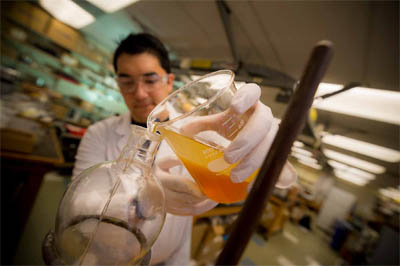
UC San Diego undergraduates in the Biodiesel Action Awareness Network (BAAN) determined how to chemically change the oil obtained from laboratory algae into different kinds of “polyols” in order to produce the core of the algae surfboard.
UC San Diego undergraduates in the Biodiesel Action Awareness Network (BAAN) determined how to chemically change the oil obtained from laboratory algae into different kinds of “polyols” in order to produce the core of the algae surfboard.
The algae surfboard not only represents the kind of collaboration that is the hallmark of UC San Diego, but the fusion of biotechnology, surfing and environmentally conscious thinking that has made the La Jolla campus and its environs such a desirable place to work and live for scientists, innovators and those who cherish the coastal environment.
Mayfield said that, like other surfers, he has long been faced with a contradiction: His connection to the pristine ocean environment requires a surfboard made from petroleum.
“As surfers more than any other sport, you are totally connected and immersed in the ocean environment,” he explained. “And yet your connection to that environment is through a piece of plastic made from fossil fuels.”
But now, he explained, surfers can have a way to surf a board that, at least at its core, comes from a sustainable, renewable source. “In the future, we’re thinking about 100 percent of the surfboard being made that way—the fiberglass will come from renewable resources, the resin on the outside will come from a renewable resource,” Mayfield said.
“This shows that we can still enjoy the ocean, but do so in an environmentally sustainable way,” he added.
News about the Future

New technique enables magnetic patterns to be mapped in 3D
An international collaboration has succeeded in using synchrotron light to detect and record the complex 3D magnetisation in wound magnetic layers. This technique could be important in the development of devices that are highly sensitive to magnetic fields, such as in medical diagnostics for example. Their results are published now in Nature Communications.
3D structures in materials and biological samples can be investigated today using X-ray tomography. This is done by recording images layer-by-layer and assembling them on a computer into a three-dimensional mapping. But so far there has been no comparable technique for imaging 3D magnetic structures on nm length scales. Now teams from HZB and the Institut für Festkörperphysik / Technische Universität Dresden in collaboration with research partners from institutions in California have developed a technique with which this is possible.

WikiHouse
WikiHouse is an open source building system. Many designers, collaborating to make it simple for everyone to design, print and assemble beautiful, low-energy homes, customised to their needs.
Open challenge
To develop a global catalogue of high performance, low-cost, low-energy solutions for sustainable homes & neighbourhoods; accessible to everyone. This includes not just houses themselves, but the ecology around them: from the planning & production of neighbourhoods, to off-grid energy and sanitation, to sensors & devices that allow citizens to understand and control their homes. You can collaborate by taking on one of these challenges and developing a solution in line with the WikiHouse principles and standards – then share that solution. The power of open source is that once solved, each problem will always be solved for everyone, forever; and will continue to evolve as it is improved and adapted.
Nature Is Speaking – Harrison Ford is The Ocean Conservation International (CI)
Recommended Book: The Upcycle Beyond Sustainability – Designing for Abundance

Who Are We?:
Religious, Philosophical, Scientific and Transhumanist Theories Of Human Nature
Kindle Edition
by John G. Messerly (Author)
Who Are We? Religious, Philosophical, Scientific, and Transhumanist Theories of Human Nature examines religious, philosophical, scientific and transhumanist theories of human nature. It begins by discussing various religious views of human nature – Confucianism, Hinduism, Buddhism, and Judeo-Christianity. Then, it looks at the philosophical theories of human nature advanced by Plato, Aristotle, Epicurus, Kant, Sartre, Marx and Freud. Next it turns to Darwin and the neo-Darwinians for insights into human nature from evolutionary biology. The book concludes by considering the future of human nature, especially how science and technology will transform human nature into something transhuman or post-human.

Creative Intelligence:
Harnessing the Power to Create, Connect, and Inspire
by Bruce Nussbaum
Offering insights from the spheres of anthropology, psychology, education, design, and business, Creative Intelligence by Bruce Nussbaum, a leading thinker, commentator, and curator on the subjects of design, creativity, and innovation, is first book to identify and explore creative intelligence as a new form of cultural literacy and as a powerful method for problem-solving, driving innovation, and sparking start-up capitalism.
Nussbaum investigates the ways in which individuals, corporations, and nations are boosting their creative intelligence — CQ — and how that translates into their abilities to make new products and solve new problems. Ultimately, Creative Intelligence shows how to frame problems in new ways and devise solutions that are original and highly social.
Smart and eye opening, Creative Intelligence: Harnessing the Power to Create, Connect, and Inspire illustrates how to connect our creative output with a new type of economic system, Indie Capitalism, where creativity is the source of value, where entrepreneurs drive growth, and where social networks are the building blocks of the economy.
Contrasting futures for the ocean give a stark warning to governments ahead of Paris climate negotiations
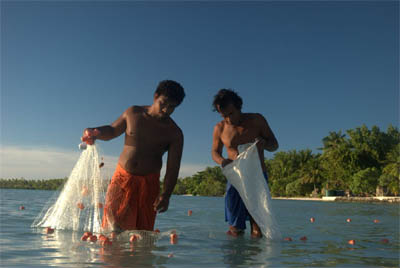
The Oceans 2015 Initiative was launched to provide COP21 negotiators with key information on how the future ocean will look like.
The ocean moderates human-induced global warming but at the cost of profound alterations to its physics, chemistry, ecology and ecosystems services. These are the findings of a report published today in Science by the Oceans 2015 Initiative and co-authored by IUCN World Commission on Protected Areas Marine Vice Chair, Dan Laffoley.
The report evaluates and compares two scenarios under two potential carbon dioxide emissions pathways over this century. Both carry high risks to vulnerable ecosystems, such as warm-water corals and mid-latitude bivalve species (molluscs), but a business-as-usual scenario was projected to be particularly devastating with a high risk of widespread species mortalities.
Lead author, Jean-Pierre Gattuso, Senior Scientist at CNRS (Centre National de la Recherche Scientifique, France), hopes that the findings of the report will generate the political will to enforce meaningful cuts in carbon dioxide emissions, stating “The oceans have been minimally considered at previous climate negotiations; our study provides compelling arguments for a radical change at COP21 (the UN climate summit in Paris in December)”.
Driven by 40% increases in atmospheric carbon dioxide (CO2), the oceans have already undergone a series of major environmental changes in terms of ocean warming, ocean acidification and sea level rise. Whilst the report finds that emissions cuts in line with the Copenhagen Accord target of less than 2 degrees temperature rise by 2100 would ensure moderate impacts to all but the most vulnerable of species, failure to achieve this goal would lead to high impacts on all the marine organism groups considered. These include high-value species such as corals and finfish as well as pteropods (shell-bearing zooplankton) and krill that form the base of the oceanic food chain.
The report singles out ocean acidification as one of the highest risks with the biggest impacts; shellfish, corals and zooplankton are particularly at risk. “Signs of ocean acidification have now been detected in both hemispheres,” warns Carl Gustaf Lundin, Director of IUCN’s Global Marine and Polar Programme. “Once thought to be a problem for the future, acidification is already having economic repercussions today and, if carbon emissions continue to grow, these are set to grow rapidly.”
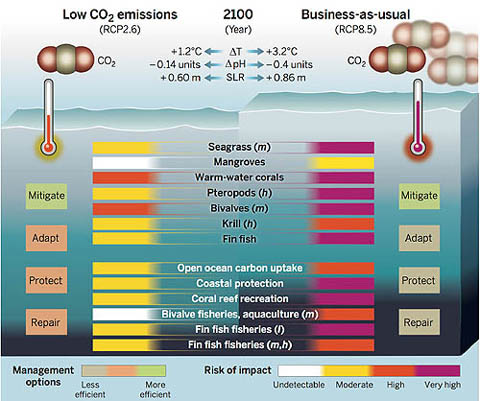
Contrasting futures for ocean and society from different anthropogenic CO2 emissions scenarios. Science
Photo: Gattuso et al, Science, July 2015
What can be done?
Beyond the stringent emissions cuts needed to meet the Copenhagen Accord target, the authors stress the need for recognition of the ocean’s important role in climate regulation and acknowledgement of its particular vulnerability. “Any new climate regime that fails to minimise ocean impacts will be seen as incomplete and inadequate,” says Laffoley. “Implementation of further Marine Protected Area networks and investment in coastal ecosystem restoration are two important ways to ensure the ocean can remain resilient and can continue to regulate the Earth’s climate.”
Futurist Portrait: Hans Rosling
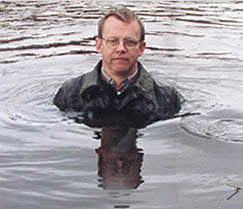
Hans Rosling,
Professor of International Health
Karolinska Institutet, Stockholm
Director of Gapminder Foundation
Hans Rosling is professor of International Health at Karolinska Institutet, the medical university in Stockholm, Sweden. When working as a young doctor in Mozambique he discovered a
previously unrecognized paralytic disease that his research team
named Konzo. His 20 years of research on global health concerned the character of the links between economy and health in Africa, Asia and Latin America.
He has been adviser to WHO and UNICEF, co-founded Médecines sans Frontiers in Sweden and started new courses and published a textbook on Global Health. He is a member of the International Group of the Swedish Academy of Science and of the Global Agenda Network of the World Economic Forum in Switzerland.
He co-founded Gapminder Foundation with son and daughter-in-law. Gapminder promotes a fact based world view by converting the international
statistics into moving, interactive, understandable and enjoyable graphics. This was first done by developing the Trendalyzer software that Google acquired in 2007. Using animations of global trends Hans Rosling lectures about past and contemporary economic, social and environmental changes in the world and he produces thematic videos using the same technique. His award-winning lectures on global trends have been labeled “humorous, yet deadly serious” and many in the audience realize their own world view is lagging many decades.
Hans Rosling’s 5 points on global trends are:
- There are no longer two types of countries in the world, the old div
ision into industrialized and developing countries has been replaced by 192 countries on a continuum of socio-economic development. - Many Asian countries are now improving twice as fast as Europe ever did.
- A new gap may form between 5 billion people moving towards healthy lives with education, cell phones, electricity, washing machines and health service and more than 1 billion people stuck in the vicious circle of absolute poverty and disease.
- So far all progress towards health and wealth has been achieved at the price of increased CO2 emission that drives the imminent climate crisis.
- There are reasons for optimism regarding the future of the world because the world is so poorly governed at present. Hence we have enormous opportunities to improve the life of all humans by turning our already converging world into an equal, secure, sustainable and free place to live in.
“Don’t Panic” – Hans Rosling showing the facts about population
The world might not be as bad as you might believe!
“Don’t Panic” is a one-hour long documentary produced by Wingspan Productions and broadcasted on BBC on the 7th of November 2013.
The visualizations are based on original graphics and stories by Gapminder and the underlaying data-sources are listed here. Hans presents some results from our UK Ignorance Survey described here.
Agenda
Watch The Future Now Show!

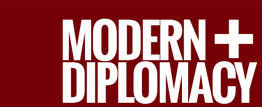
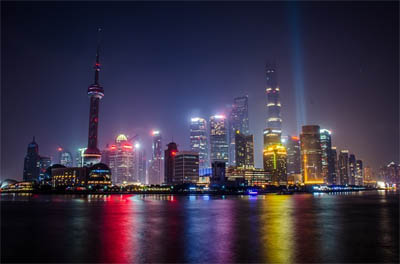






Customer Reviews
Thanks for submitting your comment!